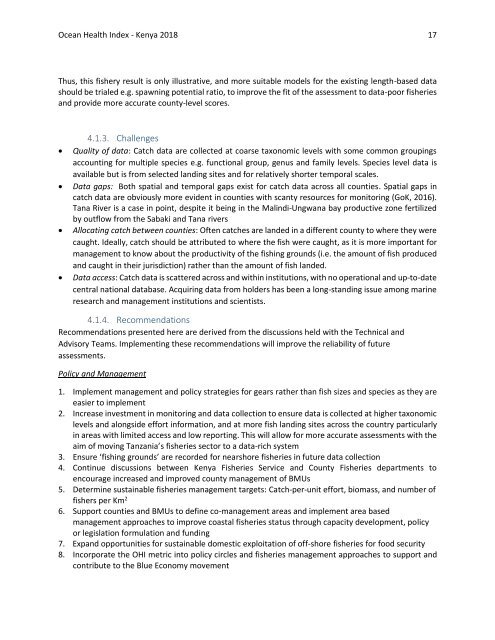Create successful ePaper yourself
Turn your PDF publications into a flip-book with our unique Google optimized e-Paper software.
Ocean Health Index - <strong>Kenya</strong> <strong>2018</strong> 17<br />
Thus, this fishery result is only illustrative, and more suitable models for the existing length-based data<br />
should be trialed e.g. spawning potential ratio, to improve the fit of the assessment to data-poor fisheries<br />
and provide more accurate county-level scores.<br />
4.1.3. Challenges<br />
• Quality of data: Catch data are collected at coarse taxonomic levels with some common groupings<br />
accounting for multiple species e.g. functional group, genus and family levels. Species level data is<br />
available but is from selected landing sites and for relatively shorter temporal scales.<br />
• Data gaps: Both spatial and temporal gaps exist for catch data across all counties. Spatial gaps in<br />
catch data are obviously more evident in counties with scanty resources for monitoring (GoK, 2016).<br />
Tana River is a case in point, despite it being in the Malindi-Ungwana bay productive zone fertilized<br />
by outflow from the Sabaki and Tana rivers<br />
• Allocating catch between counties: Often catches are landed in a different county to where they were<br />
caught. Ideally, catch should be attributed to where the fish were caught, as it is more important for<br />
management to know about the productivity of the fishing grounds (i.e. the amount of fish produced<br />
and caught in their jurisdiction) rather than the amount of fish landed.<br />
• Data access: Catch data is scattered across and within institutions, with no operational and up-to-date<br />
central national database. Acquiring data from holders has been a long-standing issue among marine<br />
research and management institutions and scientists.<br />
4.1.4. Recommendations<br />
Recommendations presented here are derived from the discussions held with the <strong>Technical</strong> and<br />
Advisory Teams. Implementing these recommendations will improve the reliability of future<br />
assessments.<br />
Policy and Management<br />
1. Implement management and policy strategies for gears rather than fish sizes and species as they are<br />
easier to implement<br />
2. Increase investment in monitoring and data collection to ensure data is collected at higher taxonomic<br />
levels and alongside effort information, and at more fish landing sites across the country particularly<br />
in areas with limited access and low reporting. This will allow for more accurate assessments with the<br />
aim of moving Tanzania’s fisheries sector to a data-rich system<br />
3. Ensure ‘fishing grounds’ are recorded for nearshore fisheries in future data collection<br />
4. Continue discussions between <strong>Kenya</strong> Fisheries Service and County Fisheries departments to<br />
encourage increased and improved county management of BMUs<br />
5. Determine sustainable fisheries management targets: Catch-per-unit effort, biomass, and number of<br />
fishers per Km 2<br />
6. Support counties and BMUs to define co-management areas and implement area based<br />
management approaches to improve coastal fisheries status through capacity development, policy<br />
or legislation formulation and funding<br />
7. Expand opportunities for sustainable domestic exploitation of off-shore fisheries for food security<br />
8. Incorporate the OHI metric into policy circles and fisheries management approaches to support and<br />
contribute to the Blue Economy movement


















